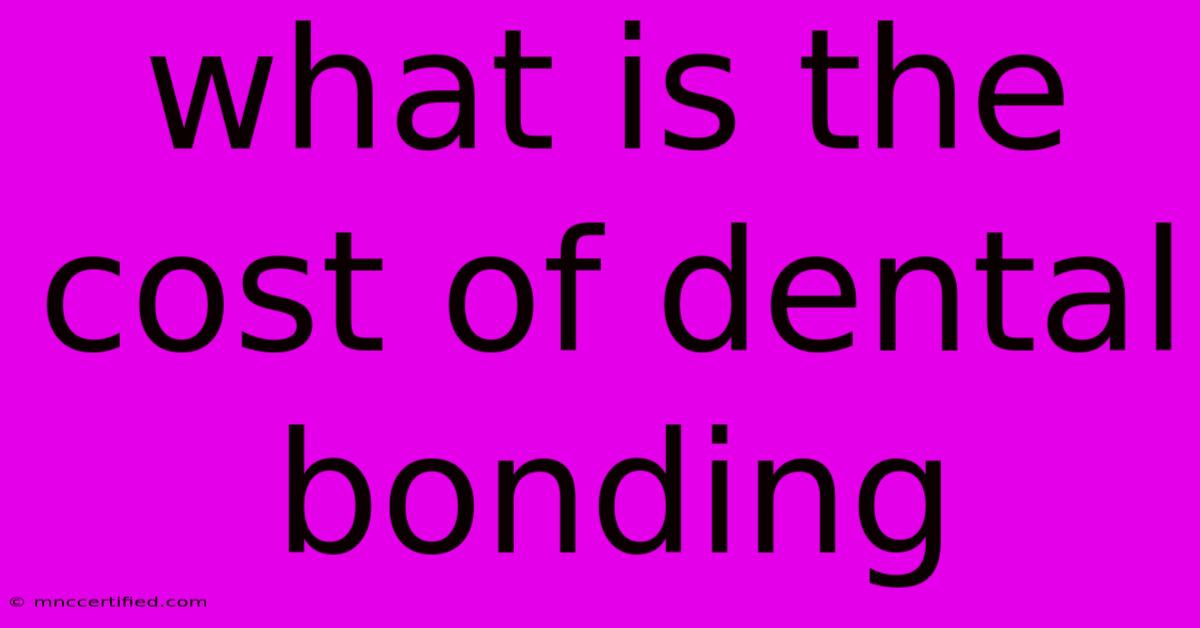What Is The Cost Of Dental Bonding

Table of Contents
What is the Cost of Dental Bonding? A Comprehensive Guide
Dental bonding is a popular cosmetic dentistry procedure used to improve the appearance of teeth. It involves applying a tooth-colored resin material to the teeth and then hardening it with a special light. This procedure can fix chipped, cracked, discolored, or gapped teeth, providing a more aesthetically pleasing smile. But a common question many patients have is: What is the cost of dental bonding? The answer, unfortunately, isn't a simple number. Several factors influence the final price.
Factors Affecting the Cost of Dental Bonding
The cost of dental bonding can vary significantly depending on several key factors:
1. Location: Geographic Variations
The cost of living and the general pricing structure of dental practices vary widely depending on your location. Dental bonding costs in major metropolitan areas tend to be higher than in smaller towns or rural areas. Research local dentists and compare their pricing before making a decision.
2. Number of Teeth Treated: More Teeth, Higher Cost
The more teeth requiring bonding, the higher the overall cost. A single tooth might be relatively inexpensive, but bonding multiple teeth will naturally increase the total price. This is a direct correlation; the number of teeth directly impacts the procedure's duration and material usage.
3. Extent of Repair: Complexity and Material Use
Simple cosmetic improvements, like covering minor chips or discoloration, will be less expensive than complex repairs involving significant reshaping or extensive bonding. The complexity of the procedure, including the amount of resin needed, influences the final price.
4. Dentist's Experience and Expertise: Skill and Reputation Matter
Experienced and highly-skilled cosmetic dentists often charge more than dentists with less experience. Their expertise and reputation often command higher fees, but you'll often find that the quality of work justifies the higher cost. Researching dentists' qualifications and patient reviews can be invaluable.
5. Additional Services: Beyond Basic Bonding
If other procedures are needed in conjunction with bonding, such as teeth cleaning or X-rays, these will add to the total cost. Always clarify the inclusion or exclusion of any additional services when discussing pricing.
Average Cost Ranges for Dental Bonding
While it's impossible to give an exact figure, a general range can be helpful. The average cost of dental bonding per tooth in the United States is typically between $300 and $600. However, this is just an estimate, and the actual cost can fall outside this range depending on the factors discussed above.
It's essential to remember that this is only the average cost. Prices can vary significantly across dental practices.
Getting a Precise Cost Estimate
The best way to determine the exact cost of dental bonding for your specific needs is to schedule a consultation with a dentist. During this consultation, the dentist will examine your teeth, discuss your goals, and provide a detailed, personalized cost estimate. Don't hesitate to ask questions about the procedure, materials used, payment options, and any potential additional costs.
Insurance Coverage: Check Your Policy
Some dental insurance plans cover cosmetic procedures like bonding, but coverage varies widely. Contact your insurance provider to determine your specific coverage before proceeding with the treatment. This can significantly impact your out-of-pocket expenses.
Conclusion: Prioritize Quality and Consultation
The cost of dental bonding is a multifaceted issue. While saving money is important, prioritizing quality and choosing a reputable dentist is crucial. Remember to always schedule a consultation to receive an accurate cost estimate and to discuss any concerns you may have. A healthy and beautiful smile is a worthwhile investment; make an informed decision based on all the factors involved.

Thank you for visiting our website wich cover about What Is The Cost Of Dental Bonding. We hope the information provided has been useful to you. Feel free to contact us if you have any questions or need further assistance. See you next time and dont miss to bookmark.
Featured Posts
-
The Onion Buys Alex Jones Media Firm
Nov 15, 2024
-
Will Dental Insurance Cover Crowns
Nov 15, 2024
-
Mean Reversion Trading Strategy Pdf
Nov 15, 2024
-
Nations League England Moves Above Greece
Nov 15, 2024
-
Where To Watch Eagles Game Tonight
Nov 15, 2024